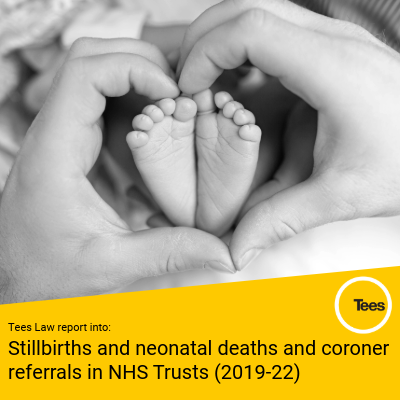FOI report: Stillbirths, neonatal deaths and coroner referrals

Tees Law has released a Freedom of Information report that analyses and draws conclusions from the responses provided by NHS Trusts on patient safety during maternity and neonatal care.
In 2015, the UK government set an ambition to halve the rates of stillbirths, neonatal deaths, and maternal deaths in England by 2030. Jeremy Hunt, the then-health secretary, announced, “We will ensure every mother and baby receives the best and safest care, 24 hours a day, 7 days a week.”
The ambition to halve the number of stillbirths set a target rate of 2.3 per thousand live births, which, according to NHS England, could potentially avoid more than 1,500 such deaths every year.
Despite these pledges, improvements in maternity services have been slow since 2015. Regular high-profile media cases have continued to reveal concerns in several NHS Trusts, with the publication of:
- the Ockendon report on 30 March 2022 following an independent review of maternity services at The Shrewsbury and Telford Hospital NHS Trust – these included recommendations for immediate and essential actions to improve patient care and safety
- the ‘Reading the signals’ report on East Kent Hospitals University NHS Trust – this highlighted four areas to be addressed to “break the cycle of endlessly repeating supposedly one-off catastrophic failures” and
- the awaited inquiry into maternity care at Nottingham University Hospitals NHS Trust.
The failures at Shrewsbury and Telford Hospital NHS Trust, which hit the news in early 2022, led to the independent inquiry which found that mothers and babies died or suffered major injuries due to “repeated failures” at the Trust, with the report calling this the UK’s biggest maternity scandal, although the investigations at Nottingham may well supersede this.
The data published by the Office for National Statistics (ONS) for the calendar year 2022 showed a stillbirth rate of 4.0 (per thousand live births). However, while this data does provide a breakdown by, for example, baby gender, mother’s age, and area of usual residence, it doesn’t provide figures for each NHS Trust.
In this context, and having handled many medical negligence claims at Tees, we undertook our own research to investigate the progress that individual NHS Trusts are making towards their targets – at roughly the halfway mark to 2030. Tees’ lawyers have seen firsthand the disparities and devastation that poor maternal care across different NHS Trusts has on families and staff.
When taking cases to inquest, a lack of consistency has been characteristic of how neonatal deaths or maternal deaths have been dealt with.
Following the publication of Tees’ report on Maternal Requests for Caesarean Section in December 2021, this new report sheds light on the state of stillbirths, neonatal deaths and maternal deaths across NHS Trusts.
Gathering the data involved sending a freedom of information (FOI) survey to NHS Trusts in England, Scotland, Wales and Northern Ireland in late 2022 and collating their replies in 2023. The responses have been analysed to assess, as far as possible, the current situation for stillbirths, neonatal deaths and maternal deaths across NHS Trusts. Trusts were also asked to provide a copy of any policies regarding when cases should be referred to the Coroner.
Key findings
The absence of a response from around 70 Trusts and some incomplete responses from those who did reply is representative of the highly variable range of responses. In some cases, Trusts stated that they did not know or could not locate the data – a worrying sign as the deadline for the national target approaches.
Despite incomplete and patchy results, clear disparities between Trusts are evident. The lack of uniformity in responses heightens the conclusion that inconsistencies abound. Three key findings were:
- A concerning rate of stillbirth in some Trusts
- Significant inconsistencies in how Trusts deal with referrals of neonatal deaths to the Coroner, including in cases where the cause of death was unknown
- Confusion around the role of HSIB (Health Services Safety Investigations Body) and when cases should be referred to HSIB
Conclusions
The findings did indeed reveal a mixed picture across the country, with inconsistent stillbirth rates between Trusts and significantly different attitudes to Coroner referrals. On stillbirths, nearly all Trusts remain above the target rate of 2.3 per 1,000 live births, with some consistently and significantly above 5 per thousand. On Coroner referrals, rates range from 0% to 100% amidst a confused picture of contradictory advice. On HSIB referrals, it appears that not all cases that should necessitate a referral are being referred, while many Trusts are either unsure of or unwilling to provide up-to-date information.
These stillbirth and referral rate variations remain a matter of significant concern.
Tees Law's own report: Read the full report here
|
|
Tees are here to help
We have many specialist lawyers who are based in:
Cambridgeshire: Cambridge
Essex: Brentwood, Chelmsford, and Saffron Walden
Hertfordshire: Bishop's Stortford and Royston
But we can help you wherever you are in England and Wales.
